Renewable energy sources are placed vital Renewable system placed vital role in the electrical power generation due to reducing of fossil fuels. Wind energy system most popular generation in renewable system .wind turbine integrated with tower building more popular in wind energy system. . A wind energy conversion system differs from a conventional power system. The output of the generator depends up on the wind character so, where as the power output of a wind energy system on the wind character only. The appeal of integrating wind turbines in to our buildings is strong. Rooftops are elevated above ground, where it’s winder: the electricity is generated right where it’s needed: and wind energy can make a strong visual statement this nature of wind energy system makes it difficult for analysis, design and management. Various approaches have been developed to study the behavior of wind energy system. A valid choice for Operation of such systems may be the use of the induction machine. The study present power and torque characteristics of the wind energy system using the model of the induction machine with different pitch angle position applied different wind conditions. Induction generators driven with gear box and wind turbine system simulation results are developed in MATLAB for building tower applications.
Keywords |
| Wind gear box, Induction generator, Variation with time, Wind turbine. |
INTRODUCTION |
| Harnessing renewable alternative energy is the ideal way to tackle the energy crisis, with due consideration given to
environmental pollution, that looms large over the world. Renewable energy is the energy which is from natural
resources like solar, wind and wave energy. Renewable energy is also called "clean energy" or "green power" because
it doesn’t pollute the air or the water. Wind energy is one such renewable energy source that harnesses natural wind
power. It proved a potential source for generation of electricity with minimal environmental impact; it is the fastestgrowing
source for electric power generation. Building towers is constructed depends on wind conditions only so on
the tower surface the wind speed is nearly 75m/h to 90m/h. according to that wind speed generate wind power on
tower. On the surface of the tower continuity wind flow happen so continuity power generation happen. The appeal of
integrating wind turbines in to our buildings is strong. Rooftops are elevated above ground, where it’s winder; the
electricity is generated right where it’s needed; and wind energy can make a strong visual statement. The wind
industry pursued the significant economies of scale with larger turbines, leading to machines with output in the tens of
kW, then hundreds of kW, then in the megawatt (MW) scale. |
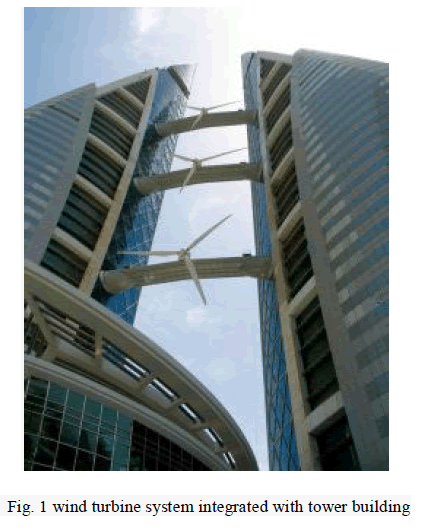 |
| The wind industry pursued the significant economies of scale with larger turbines, leading to machines with best
controllers. System design required knowledge of representative average wind conditions, as well as information on the
turbulent nature of the wind. This information is used in the design of a wind turbine intended for a particular site,
using aerodynamic principles; wind energy is converted into mechanical energy which is given as input to the induction
generator. Wind energy system based on the wind characteristics. Variation of wind speed in time, Short-term wind
speed variations of interest include ramp and gust. Show the output from an anemometer, shows the type of short term
wind speed variations that nominally exist. Various approaches have been developed to study the behaviour of wind
energy system.
A valid choice for Operation of such systems may be the use of the induction machine. The study present power and
torque characteristics of the wind energy system using the model of the induction machine with different pitch angle
position applied different wind conditions. |
II. MODEL OF WIND SPEED |
| The model of the wind character is very important in particular location for design of wind turbine. The model of the
wind should be able to simulate the temporal variations of the wind velocity, which consists of gusts and ramp wind
speed changes shown in Fig.2 The wind velocity can be written as |
 |
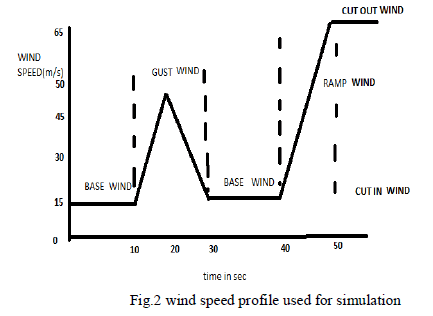 |
| The cut in velocity- the wind speed at which the turbine starts to generate power, the cut out velocity-the wind speed at
which the wind turbine is shut down to keep loads and generator power from reaching damaging levels, the rated
velocity- the wind speed at which the wind turbine reaches rated turbine power. this is often but not always, the
maximum power.
The base wind speed is a constant and is given by |
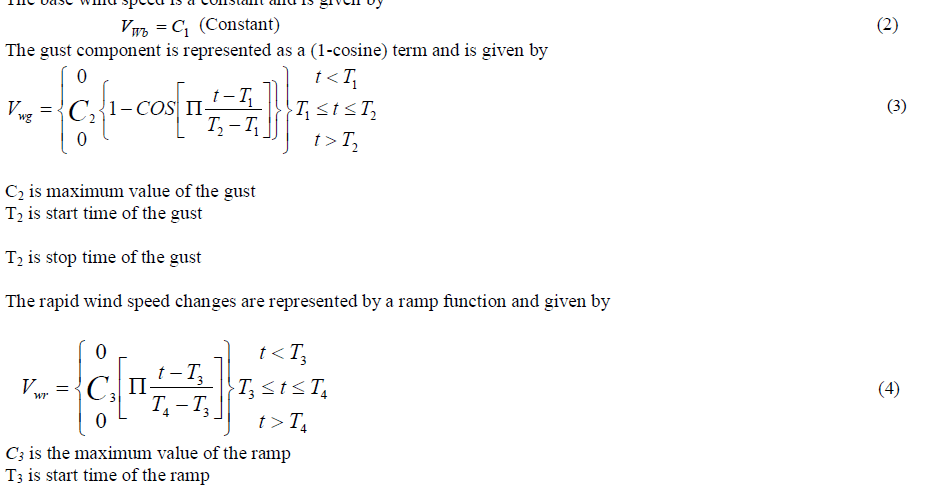 |
| T3 is start time of the ramp, |
| Equations (1) to (4) are used to model the wind characteristics and results are presented. |
III. AERODYNAMIC MODEL |
| The wind turbine continuously extracts kinetic energy from the wind by decelerating the air mass, and feeds it to the
generator as mechanical power. The aerodynamic model of the wind turbine is necessary because it gives a coupling
between the wind speed and the mechanical torque produced by the wind turbine. The mechanical power (PM),
produced by the wind turbine rotor can be defined as above. |
 |
IV. POWER COEFFICIENT WITH BETA |
| The relation between CP and λ is normally established by the CP / λ curve. This curve can be approximated using the
power/wind curve, provided by wind turbine manufacturers. |
 |
V. TORQUE COEFFICIENT WITH BETA |
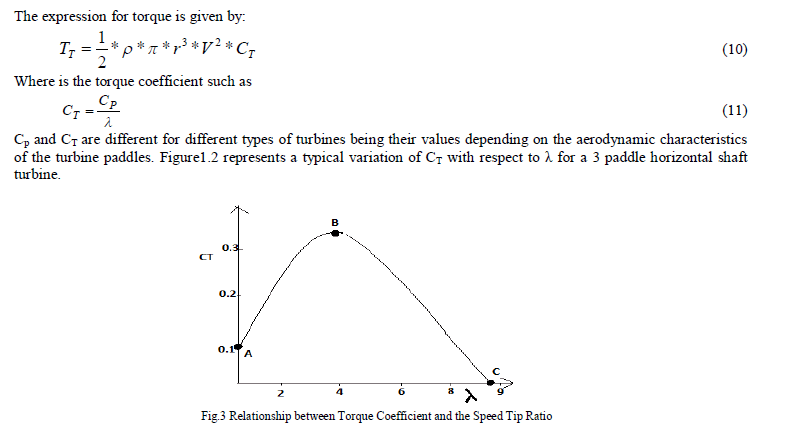 |
| Point A is the value of CT to determine the starting torque for some typical condition of wind. The between points A
and B is a region of un stability because if the resistant torque is increased due to an increase in the generator load, the
speed will decrease tending to zero as well as CT ‘ the net torque. Between points B and C, for a decreased turbine
speed, there will be an increase in CT and in the net torque, tending so to stabilize the whole system. CT Is a maximum
on point B for a maximum efficiency and maximum power transfer from the wind to the turbine in this way it is
important that the turbine operates as close to this point or to its right as possible there are several methods of load
control used to maximally convert wind energy into electrical energy [8].
These tests can be nicely tested with the turbine generator once this one follows identical torque variation of the actual
turbine. Variation of speed, power and torque as function of pitch angle and tip speed ratio presented. |
VI. GEAR BOX |
| The gearbox is used to step up the low angular speeds of the turbine (normally about 25-30rpm) to the high rotational
speeds of the generator (normally around 1800 rpm) |
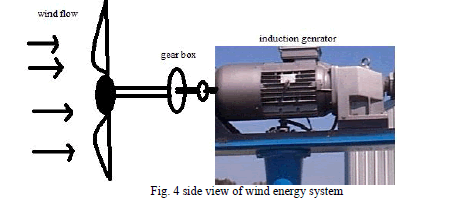 |
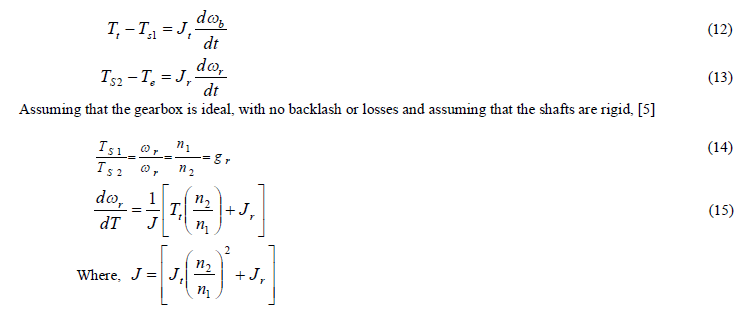 |
VII. MODEL OF 3 -PHASE INDUCTION MACHINEw |
| As the wave period and period with which the wave height varies from time to time, are both quite large compared to
the electrical time-constants involved, per phase steady state equivalent circuit of a 3-phase induction machine is used
(Figure1.4).[9] |
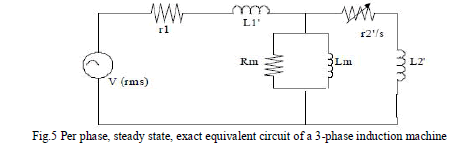 |
| Where,
V = Per phase source voltage in rms volts
r1 =Per phase stator resistance in ohm
1
1 L =Per phase stator leakage inductance in henrys
,
2 r =Per phase rotor resistance referred to stator side
1
2 L =Rotor leakage inductance referred to stator side
Rm =Resistance equivalent of the core losses in ohm
m L = Magnetization inductance of stator in henrys |
| Slip of the induction machine is given by: |
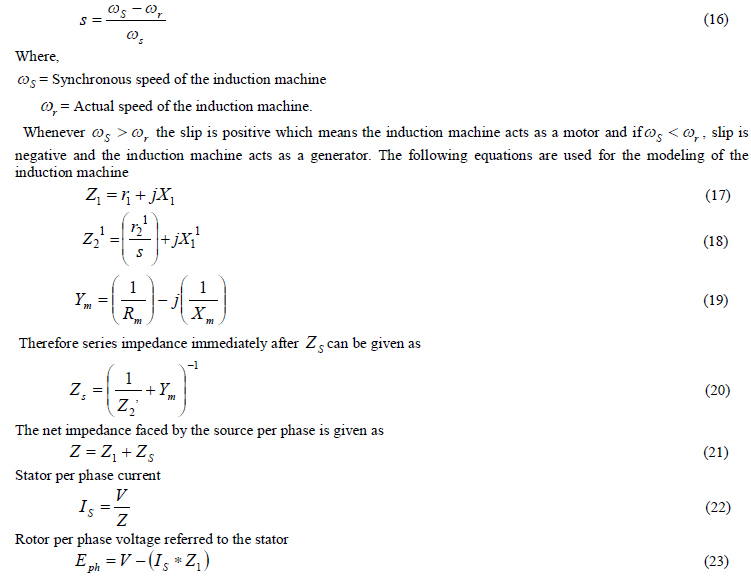 |
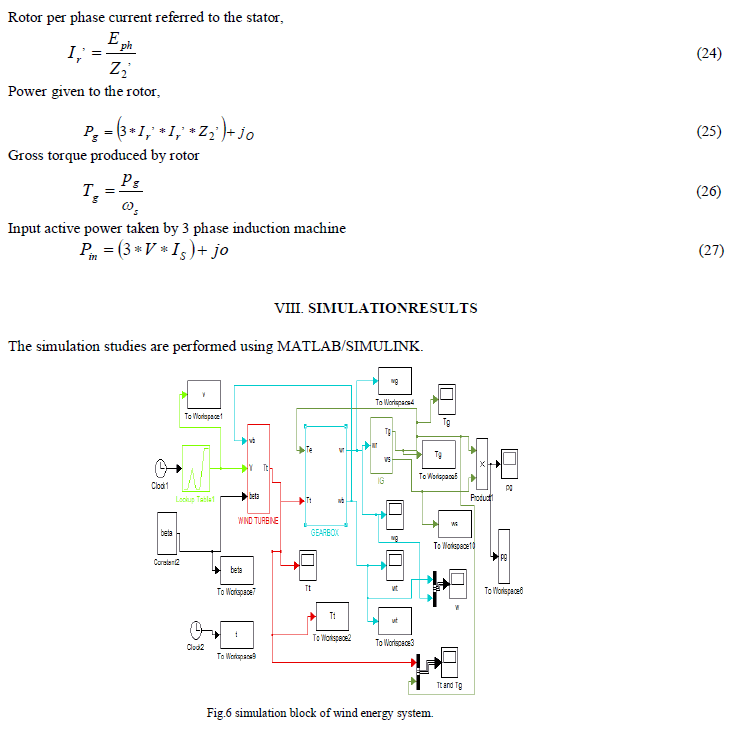 |
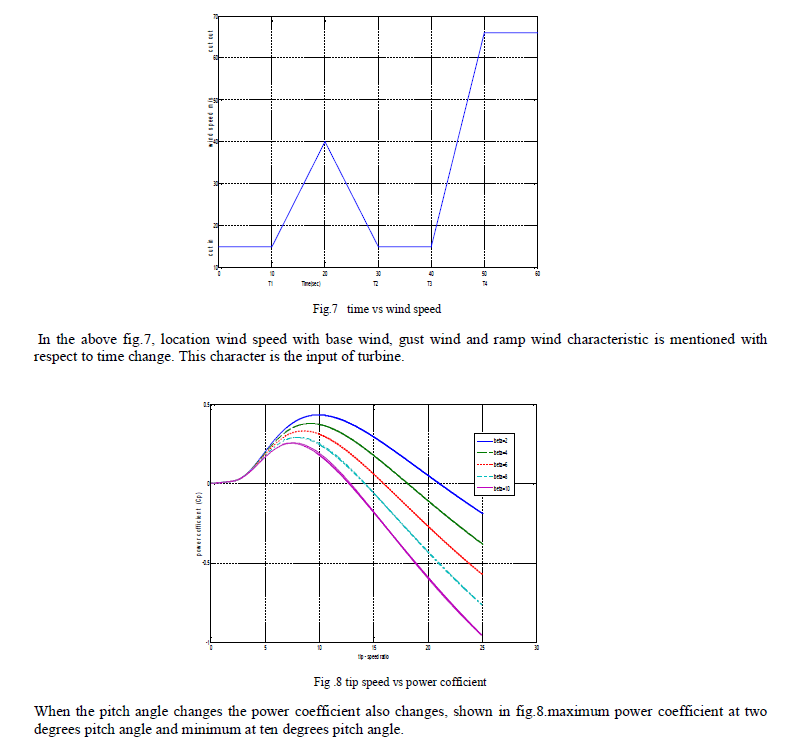 |
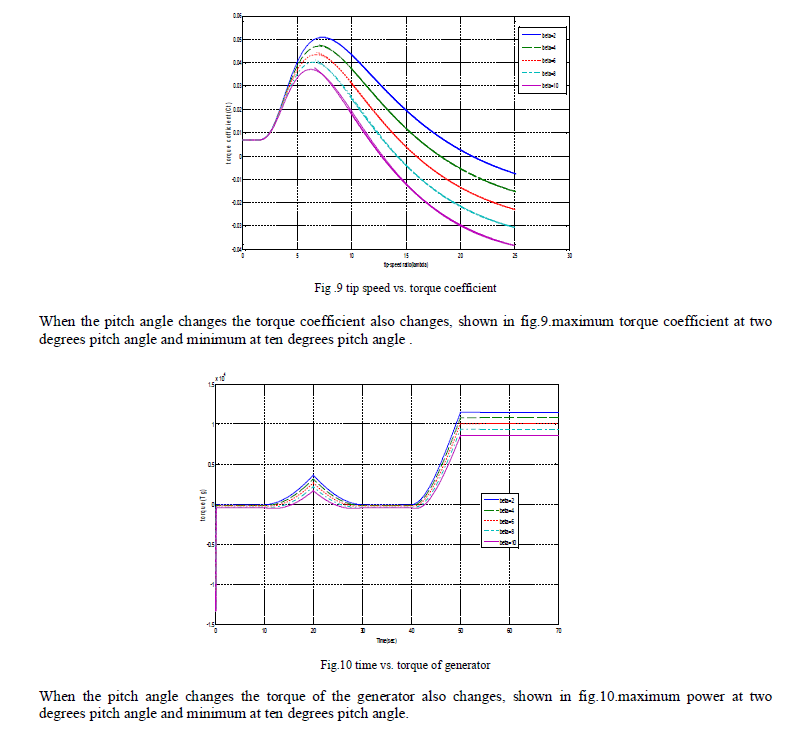 |
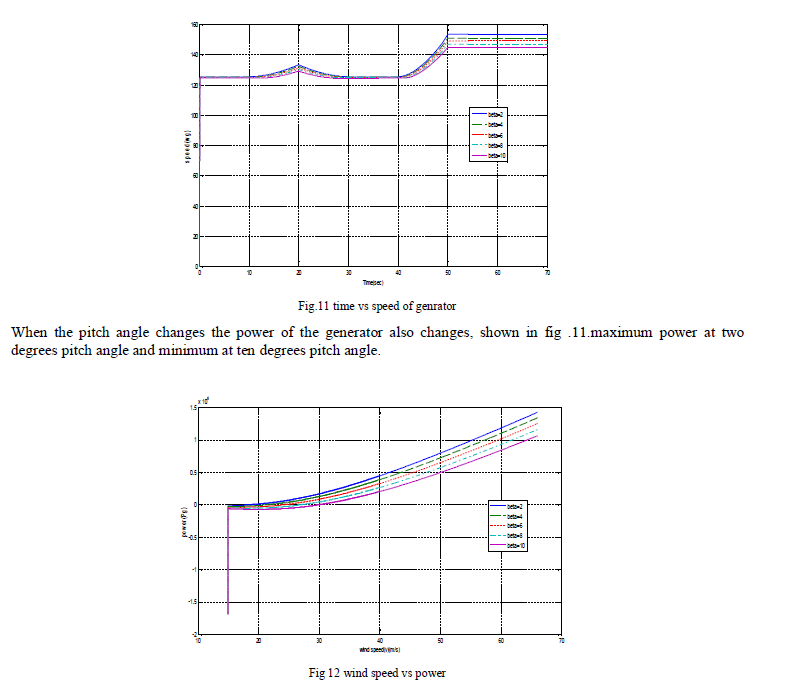 |
| When the pitch angle changes the power of the generator also changes, shown in fig12.maximum power at two degrees
pitch angle and minimum at ten degrees pitch angle. Generator output also depends on wind speed so that power
generation starts from cut in wind speed and stops from cut out wind speed. |
IX. CONCLUSION |
| The wind establishment in any location is based on the wind characteristics. For the wind model that was used in this
project, the maximum power that can be generated is 1.5MW. The maximum power generation occurs at maximum
power coefficient. From the studies, it is concluded power and torque variation of induction generator by varying pitch
angle of the wind turbine. Above results applicable for tower building applications and design of the wind energy
system performed using MATLAB/SIMULINK. |
References |
- V Ramakrishna, S.K srivatsa âÃâ¬ÃÅMathematical modeling of wind energy systemsâÃâ¬ÃÂ.
- Farret F. A., PhD, Gules.K and Marian. J. âÃâ¬ÃÅMicro âÃâ¬Ãâ turbine simulator based on speed and torque of a dc motor to drive actually loadedgeneratorsâÃâ¬ÃÂ.
- K Buehring, U. Tech And L. L. Freris, "Control Polices For Wind-Energy Conversion basic) Systems", IEE Proc., Vol. 128, Pt C, NOS,Pp 253- 261, September 1981
- S.Muthukumar,SandeepKakumanu, S.Sriram, R.Desai, A.A.S.Babar, V.Jayashankar âÃâ¬ÃÅOn minimizing the fluctuations in the powergenerated from a wave energy plantâÃâ¬ÃÂ.
- Wiley, âÃâ¬ÃÅwind energy explained theory, design and applicationâÃâ¬Ã J.F man well, J.G. McGowan, A.L. Rogers.
- John Twidell, Tony Weir âÃâ¬ÃÅRenewable Energy ResourcesâÃâ¬ÃÂ, Tylor& Francis.
- J.fmanwell,j.gmcgown and A.L Rogers, âÃâ¬ÃÅWind Energy Explained Theory,Design And ApplicationâÃâ¬ÃÂ, John Willey & Sons, Ltd.
- Brendan fox, Damian,leslieBryans,Richard Watson, âÃâ¬ÃÅWind power integration connection and system operational aspectsâÃâ¬ÃÂ, IET Powerand Energy Series.
- S.N.Bhadra,d, Kastha,s.Banerjee, âÃâ¬ÃÅWind Electrical SystemsâÃâ¬ÃÂ, Oxford.
- Muljadi,E. âÃâ¬ÃÅPitch-controlled variable-speed wind turbine generationâÃâ¬Ã Industry Applications Conference, 1999. Thirty- Fourth IAS AnnualMeeting, Conference Record of the 1999 IEEE.
- Y. HU Senior Member, IEEE, Zhe CHEN, Senior Member, IEEE âÃâ¬ÃÅStudy of Induction Generator based Wind Turbine SystemsâÃâ¬Ã TheInternational Conference on Electrical Engineering2009.
- Kapil Parikh, AshishMaheshwari, VineshAgarwal âÃâ¬ÃÅModeling, Simulation and Performance Analysis of AC-DC-AC PWM ConvertersBased Wind Energy Conversion SystemâÃâ¬Ã International Journal of Recent Technology and Engineering (IJRTE) ISSN: 2277-3878, Volume-2, Issue-4, September 2013.
- Zhe Chen, Senior Member, IEEE, Josep M. Guerrero, Senior Member, IEEE, and FredeBlaabjerg, Fellow, IEEEâÃâ¬Ã A Review of the State ofthe Art of Power Electronics for Wind TurbinesâÃâ¬Ã IEEE TRANSACTIONS ON POWER ELECTRONICS, VOL. 24, NO. 8, AUGUST 2009.
|